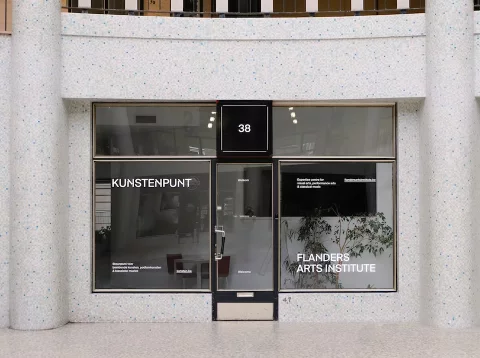
Landscape Sketch of the Arts: session cross-sectoral arts
Schedule of Landscape Sketch of the Arts session: cross-sectoral
| On Monday 2 September: | |
| 10:00 - 10:30 | Introduction Landscape Sketch |
| 10:30 - 12:15 | Break-out Rooms: Round 1 |
| 1) Cross-sectoral: what and why? | |
| 2) Is it art? | |
| 3) Processes versus products | |
| 4) Entrepreneurship and working internationally | |
| 5) Audience | |
| 6) Working together | |
| 12:15 - 13:15 | Lunch |
| 13:15 - 15:00 | Break-out Rooms: Round 2 |
| 1) Cross-sectoral: what and why? | |
| 2) Is it art? | |
| 3) Processes versus products | |
| 4) Entrepreneurship and working internationally | |
| 5) Audience | |
| 6) Working together | |
| 15:00 - 16:00 | Guided tour Timelab (optional) |
| Drink | |
-
From 10:00 to 10:30
Introduction Landscape Sketch
We will begin the plenary session with an introduction by Flanders Arts Institute about the Landscape Sketch trajectory and about the themes that we will continue to work with in the break-out groups. We are inviting professionals to think with us about the following six themes:
-
From 10:30 to 12:15
1) Cross-sectoral: what and why?
Working cross-sectorally is challenging. As an artist or organisation, among other things, you have to relate to other – often divergent – agendas, standardised methods are lacking and sustainability sometimes seems hardly evident. What motivations are there to embark on this anyway? What is the added value of cross-sectoral work, and what does it add to the arts field and wider society? Is there a shared narrative behind the diverse practices that today fall under the heading of cross-sectoral? Can we actually speak of a separate discipline, and what does that distinctiveness consist of?
-
From 10:30 to 12:15
2) Is it art?
Cross-sectoral practices challenge traditional notions of art. Trajectories often result in something that cannot be clearly recognised as a work of art, or processes are radically in the foreground. Cross-sectoral work goes against pigeonholing and prevailing frameworks. This is exciting, and brings a lot of challenges. What about the recognition of cross-sectoral work in the wider arts field? What does quality mean in the light of these content-rich practices, which do not necessarily have a purely artistic finality? To what point can we actually still talk about art, and what about artistic autonomy?
-
From 10:30 to 12:15
3) Processes versus products
A lot of cross-sectoral practices put processes at the centre, and do not necessarily culminate in a product. While that may be a conscious choice, it also makes things complex. For instance, how do you give these processes a place in the context of a presentation, which often follows standardised formats? How do you document these processes? And what implications does the absence of a product or work have for revenue models and grant applications? To what extent do cross-sector practices today conform to the standards they question?
-
From 10:30 to 12:15
4) Entrepreneurship and working internationally
Governments at different policy levels encourage cross-sectoral interactions between arts and other domains, often from the agenda of additional funding and entrepreneurship. But to what extent is this justified or desirable? And should entrepreneurship necessarily equate to a commercial approach? A lot of cross-sectoral practices just seem to represent a more social interpretation of entrepreneurship. Today, European consortia are an important lifeline for a lot of cross-sectoral players, but national resources are a quasi-indispensable tool. Moreover, subsidies at different levels are not always easy to combine because the conditions are not aligned. Is working internationally a poisoned gift today?
-
From 10:30 to 12:15
5) Audience
Cross-sectoral art breaks out of the bubble and potentially reaches new and wider audiences. But who is actually the audience of cross-sectoral art today? For whom are you doing it, and how do you make these people part of your story? How do audiences and participants relate to each other? Where sectors interact, their audiences often do too. But how evident is cross-sectoral work to traditional art audiences, and how do you engage the segments outside of them?
-
From 10:30 to 12:15
6) Working together
The common denominator of cross-sectoral art is collaboration with other domains. But who do you partner with, who takes the first step and how do you go about it? Are all sectors equally enthusiastic about collaborating with artists? What expectations are there for financial input, and where does mutual cross-pollination end and one-sided instrumentalisation or commissioned work begin? How do you strive for sustainability when initiatives are often project-based, relying on the expertise and good will of individuals? And what about collaboration with other actors in the arts?
-
From 13:15 to 15:00
Break-out Rooms: Round 2
In the afternoon, you can choose between the same six themes for the second round of break-out rooms.
-
From 15:00 to 16:00
Guided tour Timelab (optional)
To end this day, we offer the option to follow a guided tour around the building and workings of Timelab. In Timelab, they work with what is present. The building, the neighbourhood, energy streams, food, mobility, knowledge and people are the themes of various labos. This way, they re-interpret the role of the cultural organisation in the area from the inside, in a circular and resilient way.
